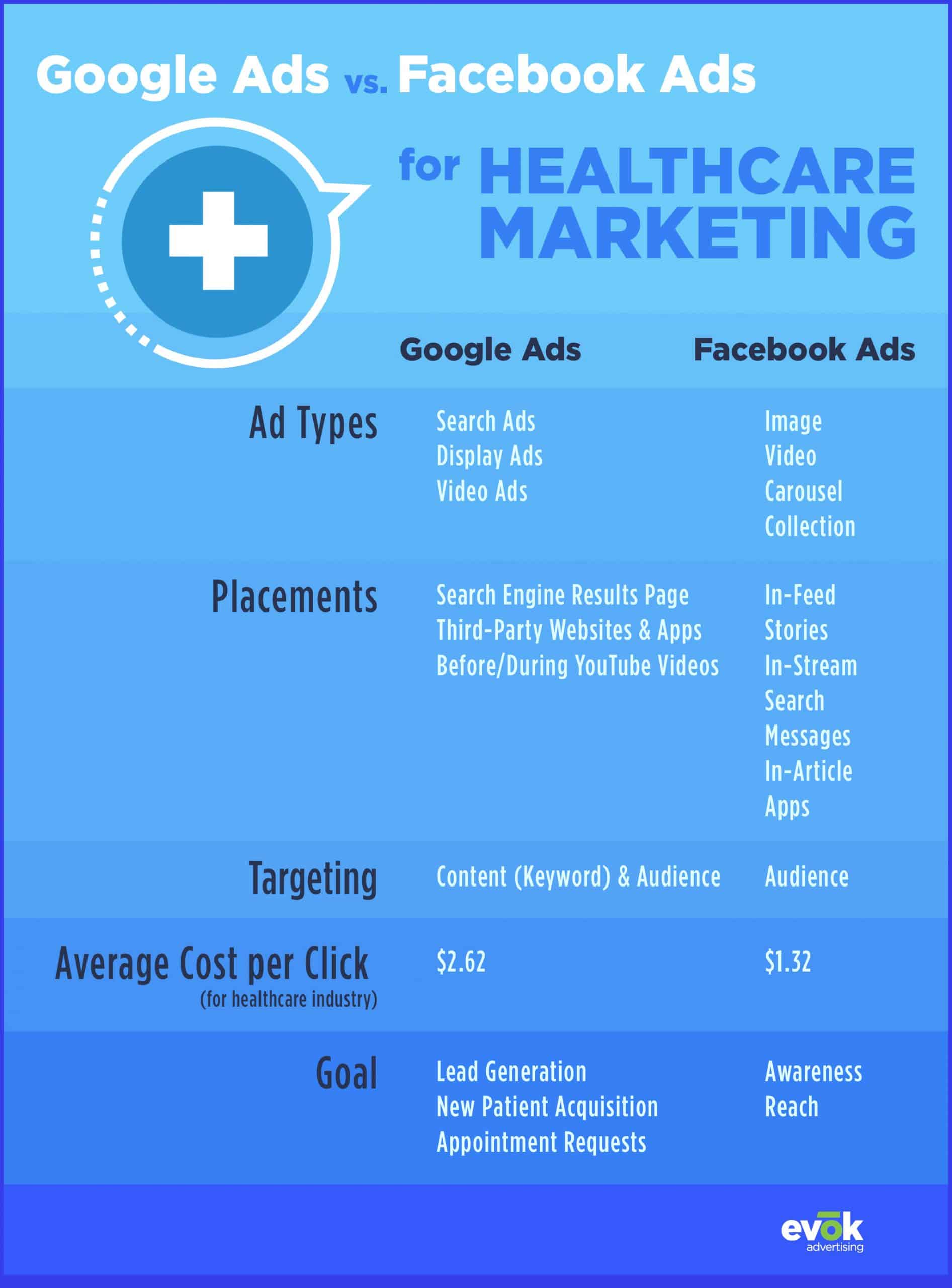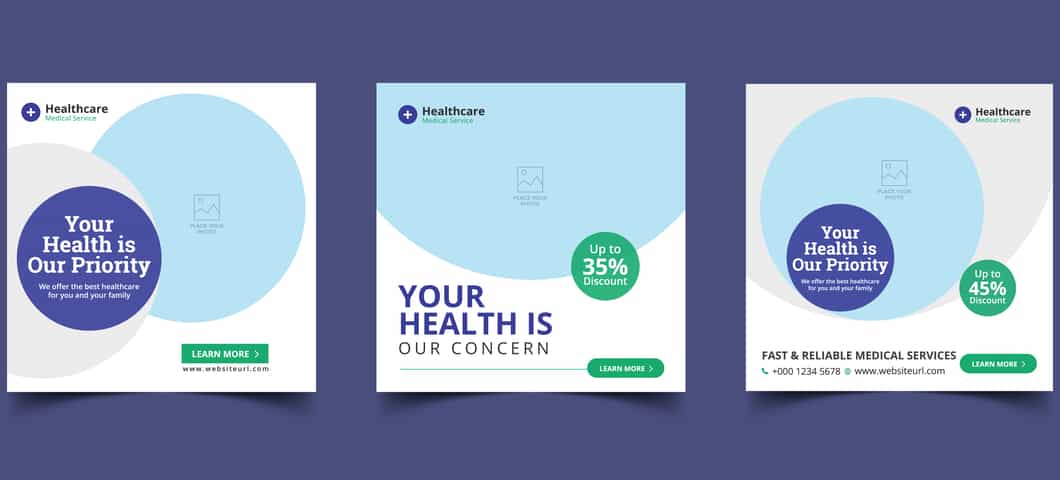
Healthcare Marketing with Google Ads vs. Facebook Ads: Increasing ROI and Engagement

For healthcare marketers, digital advertising on platforms like Google and Facebook offers a cost-effective way to attract new patients, build your doctors’ reputation within your community, and ultimately grow your practice. But, while the potential return on investment can be significant, navigating these channels can be complicated. For starters, which platform offers the greatest ROI for healthcare brands, Google or Facebook?
Before we dive into the verdict of Google vs. Facebook, it’s important to know what we are comparing. In this blog, we will cover everything from average costs per click to targeting and reach potential for both Google Ads and Facebook, as well as how to maximize your advertising budget by choosing the best platform depending on your practice’s marketing objectives.
Google Ads for Medical Practices
Campaign Types
First up, let’s examine Google Ads—formerly known as Google Adwords—and what this online advertising platform has to offer healthcare organizations. Google Ads offers multiple campaign types, with the three most common being:
- Search ads: text ads appearing on Google search engine results pages based on targeted keywords and search terms
- Display ads: image-based ads appearing on websites or apps that are part of the Google Display Network
- Video ads: short, 6- or 15-second videos playing before or during YouTube content
In this blog, we will be comparing Google’s search ads to Facebook’s similar offerings. However, display and video ads offer their own unique opportunities for healthcare brands worth exploring if they align with your budget and goals.
Intent and Objectives
Going into more detail on Google search ads, this type of campaign allows you to reach search engine users as they are looking for information online. We refer to this as intent to purchase.
A potential patient’s online search for “best optometrists near me” or “shoulder specialists in Orlando” demonstrates a need for the services offered by your practice, hospital or doctors. Based on how your search ad campaign is set up, they will be served your ad and you only pay if a user clicks on it.
Because users seeing your ad are in an active stage on their patient journey—looking for answers and service you can provide—search ads are a proven lead generation tool. That means if your practice’s main goals are to drive new patient leads and appointment requests, then Google search ads are ideal for your digital marketing strategy.
Average Costs
One of the strongest benefits digital advertising offers healthcare providers is budget flexibility. Google Ads allows you to set daily spending caps on your campaigns, so you can control exactly how much you are spending and willing to pay to drive leads and clicks to your website.
As we mentioned, with Google search ads you only pay if a person clicks on your ad. In the health and medical field, the average cost per click in Google Ads is $2.62. While that number may be higher than you would find with other ad platforms, it’s important to keep in mind that intent to purchase we talked about earlier.
If users are engaged in their search and interested in the services you offer, they may be more likely to fill out an appointment request form or call your practice directly after viewing your ad. To maximize your potential for new patient leads, ensure your ad’s landing page clearly spells out why they should consider your practice for their medical needs, including your doctors’ experience, patient testimonials and prominent and convenient calls to action.
Targeting and Reach
Targeting options on digital marketing platforms like Google and Facebook are highly advanced and designed to help you reach your patient acquisition goals. On Google Ads, marketers can target by content and audience.
Content-based targeting—serving ads based on targeted keywords—has long been the “bread and butter” of search ads. With this type of targeting, we can serve users ads relevant to the keywords and phrases they are using to search for information on Google. This is critical to intent-focused advertising, as we want to show our ads to those ready to make a decision, whether it is to schedule an appointment or fill out a form on your website.
In addition to targeting by keywords, Google Ads also allows you to target based on audience characteristics. These include age, income, interests and behavior. This way, you can ensure your ads are not only seen by those searching for services like yours, but that those users are also qualified leads for your practice. For example, you wouldn’t want to spend budget dollars serving an ad to a person in Chicago if your practice only operates in Orlando.
Facebook Advertising for Healthcare Marketers
Ad Types
Like Google Ads, Facebook advertising also offers a number of options when it comes to creating your healthcare marketing campaign. Ad types include image, video, carousel and collection ads.
Additionally, Facebook offers multiple ad placement options, including:
- Feeds: ads may appear on Facebook News feed, Instagram feed, Facebook Marketplace, Facebook Video feeds, Instagram Explore, Messenger inbox and Facebook’s right-hand column (desktop only)
- Stories: full-screen vertical ads on Facebook Stories, Instagram Stories and Messenger Stories
- In-Stream: ads appear before, during or after video content on Facebook or IGTV
- Search: ads appear on relevant Facebook search results
- Messages: ads appear as messages to those who have an existing Messenger conversation with you
- In-Article: ads appear in Facebook Instant Articles
- Apps: ads appear on external apps
Intent and Objectives
User intent differs greatly from Google to Facebook. While users turn to search engines when they’re looking for information on a specific subject, they go to social media to browse a wide spectrum of topics. These individuals may in fact be in need of a new physician or have other medical needs, but they may not be actively thinking about those needs while scrolling on Facebook or Instagram. Because of this, Facebook Ads functions more effectively as an awareness-driving platform versus direct lead generation.
With Facebook advertising, reach is the name of the game. Whether you are opening a new clinic location or are trying to make your organization a household name in your community, Facebook’s impressive targeting capabilities allow you to connect with your ideal target audience and amass sizable impression numbers.
Average Costs
Compared to Google’s search ads, Facebook’s average costs are lower, allowing marketers to reach more users for less money. The average cost per click on Facebook for the healthcare field is $1.32. Like with Google Ads, you can set daily spending limits to spread your budget out over the desired amount of time. Also like Google, you pay when users take the desired action. Based on your campaign’s objective, that may be impressions, clicks, conversions, etc.
Facebook’s relatively lower costs are especially beneficial for healthcare marketers looking to generate widespread awareness within a specific community or group of potential patients. Plus, advertising on the platform can help build your following so users will continue to see your updates organically.
Targeting and Reach
We mentioned Facebook’s powerful reach and the opportunities it presents for marketers. The platform’s immersive targeting capabilities are the key to harnessing that reach and turning your campaigns into successful business and awareness drivers for your practice.
With Facebook Ads, targeting is primarily audience based. As users spend time on Facebook, the platform gets a better and better picture of their interests, behavior and more. From the brands or pages users follow, to the topics they post about or the content they engage with, Facebook uses this information to create audience profiles. Marketers can then target users who are likely to find their content relevant. For example,
Facebook also allows marketers to target “lookalike audiences.” These audiences can be created from information like existing page followers, customers, those who’ve visited your website and more. From there, you can target other users with similar interests and profiles, so you can ensure your ads reach those likely to find them relevant.
Google Ads vs. Facebook for Healthcare Marketing: Who Wins?

When it comes to determining which ad platform delivers the greatest returns on investment for healthcare brands, the answer is not a simple win, lose or draw. Both Google and Facebook offer distinctive benefits for healthcare marketers and can lead to business-driving results. However, the key to maximizing those results is setting an objective for your digital advertising campaigns.
Are you working to drive new patient appointments to a soon-to-open clinic? Google Ads can help position your practice in front of those actively searching for clinics accepting new patients. Want to highlight a new service or procedure available at your practice? Facebook Ads can put your content in front of people in your community who may be interested in learning more about that service.
As with most marketing plans, starting with a goal in mind helps guide your efforts towards the outcome you want.